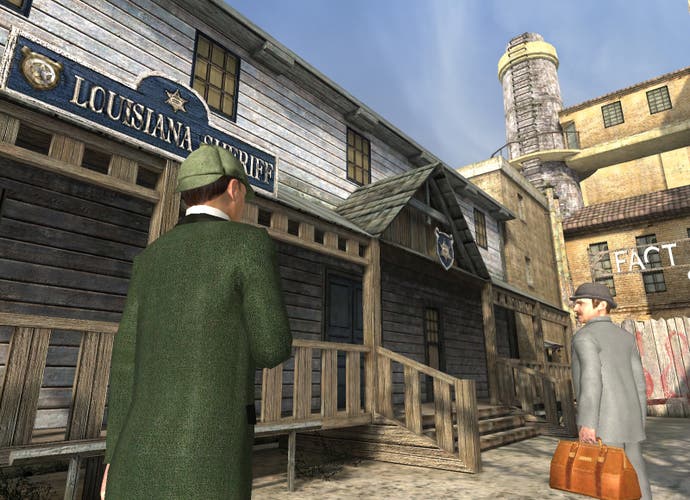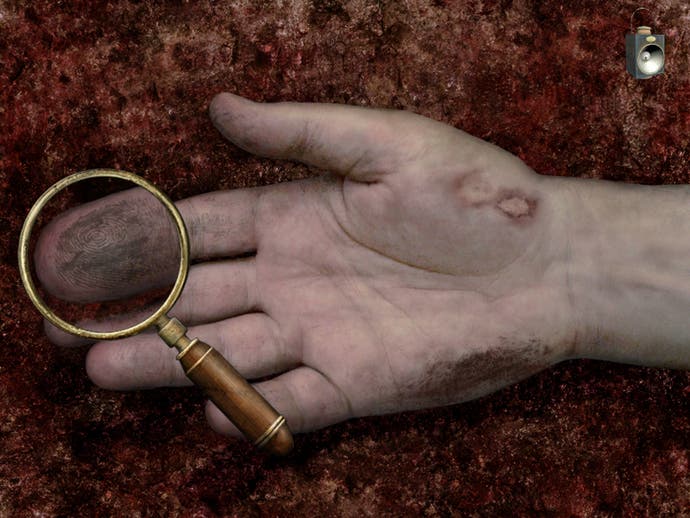Sherlock Holmes: The Awakened
A lemon tree, my dear Watson.
When there's something strange in the neighbourhood, who ya gonna call? How about a snooty and effete English detective with a weakness for floppy hats, violins and good old fashioned cocaine abuse?
Actually, "something strange" doesn't even begin to cover the neighbourhood happenings which pique the interest of the World's Greatest Detective in this follow-up to Frogware's 2004 Holmesian outing, The Secret of the Silver Earring. There's more than a mere murder plot afoot, as Baker Street's finest is embroiled in a globe-spanning plot involving none other than Cthulhu, the indescribable primordial demon-god that looms so menacingly in the works of Howard Philip Lovecraft.
That's not the only startling development in the world of Holmes, as The Awakened adapts the old point-and-click adventure template into a full 3D world and first-person viewpoint, much like the forthcoming Penumbra: Overture. You still scour the scenery for clues, and initiate conversations with NPCs but, by freeing the player from the restrictions of two-dimensional dioramas and letting you wander around actual locations, the immersion and atmosphere so vital to a tale of unworldly dread is immediately heightened.
Dimension hopping

While the switch in presentation has its advantages, it also highlights just how annoying certain adventure game traditions really are. If you thought it was a pain in the arse sweeping your mouse over a static tableaux to find out which objects are worthy of attention, try finding the miniscule clues in a sizable 3D environment with no cursor or on-screen information. As with The Silver Earring, the game won't let you progress until you've found every usable item and initiated all the right conversations, so progress can be a real test of patience as you wander around trying to figure out what you might have missed.
An early example of how 3D navigation, in conjunction with artificial gameplay parameters, conspire to confuse matters comes as you begin your investigation. The Maori servant of one of Watson's patients has gone missing, and the local constabulary are happy to chalk it up to a randy savage led astray by London's many vices. Holmes, of course, has other ideas. There are weird drawings on the floor of the servant's lodgings. A scrap of yellow cloth caught on a door frame. A lump of what appears to be opium left in a wood burner. Clues aplenty, and all easy enough to find for an experienced adventurer.
There are also footsteps leading to the garden fence. But looking at them doesn't result in one of the icons denoting an object of interest, unless you crouch down next to them, of course - a move that is apparently only useful for this specific moment. Once you figure that out, you can measure them and look closer with your magnifying glass. Then you must somehow realise that you have to click - very precisely I might add - on a missing nail in one of the footprints and also find a tiny fish scale lurking in the grass. Later on, you'll be expected to locate such insanely small clues as a pinprick on the finger of the filthy hand of a mangled corpse. As you often have no idea what you're looking for, it's quite possible to spend many deathly dull minutes methodically clicking on everything until you stumble on the required clue. It's the sort of tedious finicky chore that a move to full 3D really should have eradicated.
Blue's clues

The garden footsteps also serve to highlight how inconsistent the game can be. Follow them round to the other side of the fence and you'll see they lead to a gate. Try and open the gate and Holmes declares "I have no need to go there". Well, sorry to be a stickler for protocol, but yes you do. You're a detective, but you have "no need" to follow the footprints of a missing person? Confusingly, a later set of footprints can be investigated (and followed) without the need for crouching, but first you have to try and open a nearby locked door before Holmes will notice them, even though they're plainly visibly to the player.
The game is full of fussy obstructions like this, not helped by often misleading pronouncements from Holmes. Investigating certain objects causes him to declare that it's of "no use whatsoever", and refuse to pick them up, only for them to prove vital mere minutes later. Meanwhile, other seemingly random items can be picked up regardless of whether you've stumbled across the puzzle that requires them. The way that the game will let you walk around with a bucket full of water for ten minutes, yet concedes that a curious doll is only of use after you've found out who it belongs to, is the source of much frustrated backtracking.
Other minor irritants include unskippable and uninteractive conversations (the game features no dialogue trees, so you're never in control of what questions are asked) and periodic tests. Here, Holmes puts Watson on the spot and asks him where they need to go next to further their investigation and you don't get to move to the next major location until you work it out. Now, this idea is wonderfully in keeping with Conan Doyle's original stories, and the relationship between the two men, but it also proves to be a rather ham-fisted gameplay barrier. You get no warning as to when Holmes will deliver his quiz and, once he's asked the question, you can only input your answer. You can't call up the inventory screen to recap the clues so far, or to check previous conversations, so if you didn't pay attention to the passing reference that gives you the answer, it's entirely possible that you'll have to quit and reload in order to move onward. Grr.
With such a laundry list of complaints, most of which have a direct and negative effect on the core gameplay, I was thoroughly expecting to hate the bones of this game. And yet...
The plot thickens...

It's here that Subjectivity, the unpredictable and slovenly flatmate of our old pal Objectivity, crashes the party, helps himself to a beer from the fridge and collapses on the sofa with an almighty fart. Because, despite having deep reservations regarding The Awakened's technical worth, I found myself rather enjoying myself against my better judgment. Now, cards on the table, I'm a big fan of both Conan Doyle and Lovecraft, as well as the whole vintage mystery/horror genre, and I'm under no illusions that my predisposition to the sort of tale being told allowed me to look past the obtuse implementation and sink my teeth into the actual story.
And, unlike many of its adventure peers, story is where The Awakened shines. With their other Sherlock adventures, as well as a couple of Jules Verne adaptations, Frogwares has a proven ability in replicating the tone and verve of turn-of-the-century fantasy, and the way they blend Holmes' ruthlessly logical and pragmatic world with the gibbering paranoia and vague menace of Lovecraft is extremely effective. Fans of the HP source (arf!) will be especially pleased to learn that there are no sequences involving shambling monsters and Cthulhu doesn't turn up as an end-of-game boss. Instead you get arcane sects, eerie pictograms and the wailing horror of the madhouse. Lovecraft is hardly a Victorian author, of course, but his early works just about overlap with Conan Doyle's later Holmes adventures so the crossover never feels anachronistic. For fans of either author, it's a near-perfect combination of their respective literary worlds.
As in previous Frogwares titles, Holmes is portrayed as an aloof and infuriatingly brilliant oddball. Apparently, he's only happy when there's a thorny problem to occupy his vast intellect and often throws himself into dangerous situations with maniacal glee. Watson's long-suffering role is one of loyal exasperation, and the voice actors chosen to breath life into the script are both up to the job - even if Holmes does sound alarmingly like Tony Blair at times. Nods to the well known tropes of Sherlock's character are enjoyably subtle. They even manage to include Moriarty and Reichenbach Falls in a way that feels entirely logical, and even strangely poignant.
Even more pleasing, the game doesn't waste time. Holmes doesn't have to suffer the indignity of finding and combining half a dozen objects just to leave his house, and the plot - while appropriately sedate in its pace - gets underway immediately, with backstory threaded into the gameplay rather than holding it up. Pointless fetch quests are kept to a minimum and, if you ignore their often obtuse nature, the puzzles and riddles all have a direct relation to the actual mystery at hand, either yielding clues or opening the way to further revelations. You never feel that the game is forcing you to tread water in order to pad out the playing time. It's always story, story, story.
Yet it's hard to ignore the clumsier aspects of the game. The 3D environments, as detailed and atmospheric as most first-person shooters, hinder the adventure template as much as they help it while the over-reliance on pixel-hunting for clues and the rigidly linear structure often make it more of an interactive story than an actual game. But if you can tolerate those flaws, and your pride will allow you to keep a walkthrough to hand for getting past some of the more unfathomable moments, then the story in question is an absolute belter.

